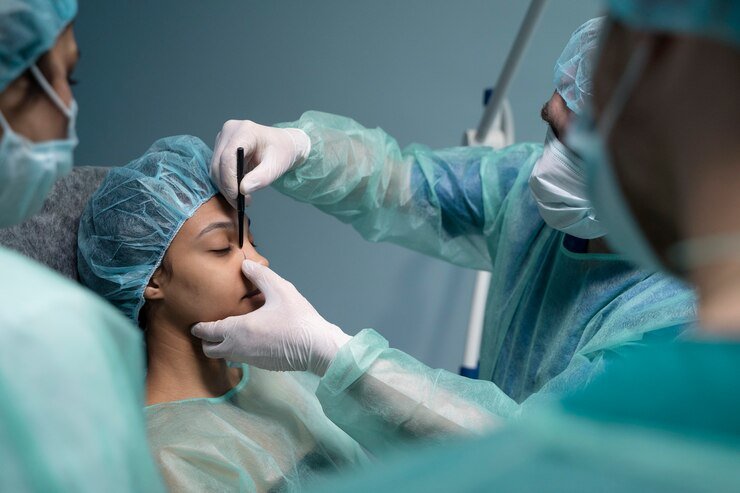Types of Rhinoplasty: Open vs. Closed Rhinoplasty
Rhinoplasty, in other words, the nose job, has two techniques open and closed, through which the surgeons change the nose shape and size for cosmetic, as well as functional purposes. Each technique of this surgery type has pros and cons of its own, and each of those is performed according to the patient’s needs. Let’s examine their synopses, benefits, drawbacks, and more in detail to comprehend their core ideas and the thinking behind the choice.
Open rhinoplasty
Out of the two techniques, open rhinoplasty is used to reshape and make the nose structure more accepted by the individual who goes through the surgery. The procedure typically includes a columella incision, which is the thin strap that separates the nostrils. By the open – external – incision, surgeons lift the skin of the nose and directly access the nose’s underlying structures which also include cartilage and bone. The key factors of open surgery are better visibility, structural modifications, and also the duration of the procedure.
Let’s start with better visibility the open rhinoplasty gives access, since with this procedure surgeons get a better view of the entire nasal framework. With this, they make precise modifications, especially in more difficult cases or revisions where a key aspect is a significant reshaping. Now, let’s view the advantages the open rhinoplasty allows when it comes to structural modifications. It is especially handy when the individual needs some extensive alterations, for example, asymmetry correction, nasal humps removal, and breath issue addressing that the best rhinoplasty surgeon will easily perform due to better access. And lastly, the procedure duration tends to take longer time than the closed rhinoplasty. This is because it has additional steps in making and choosing the external incision. So, the typical duration is usually 1.5 to 3 hours.
Advantages and disadvantages of open rhinoplasty
Open rhinoplasty gives better control over the procedure and allows the surgeons have detailed adjustments and better aesthetic outcomes. Aside from this, open surgery is ideal for more difficult cases, where serious changes are inevitable.
Some disadvantages include visible small scarring on the columella and a longer recovery period, accompanied by swelling and bruising. The small scar tends to fade over time, though in some cases it remains visible.
Closed Rhinoplasty
The industry of plastic surgery Armenia offers includes closed rhinoplasty too, which, on the other hand, involves making all of the incisions inside the nose. This method is frequently chosen for simpler operations since it reduces the amount of noticeable scarring. Through small incisions inside the nostrils, the surgeons access the nasal structures without causing potential scars. Because the external appearance of the nose is maintained, patients who are worried about scarring are more likely to select this internal approach. Under general anesthesia, the procedure typically takes one to two hours to complete. Because there are no external incisions, the procedure takes less time than an open rhinoplasty.
Advantages and disadvantages of closed rhinoplasty
There are no external scars because all incisions are made inside the nostrils, which is a big benefit for a lot of patients. Following a closed rhinoplasty, patients often experience reduced swelling and bruises, which speed up their recuperation times. Many people are able to resume their regular activities in about a week. And since there is no need for skin lifting or external structure manipulation, it is thought to be less invasive than open rhinoplasty.
Compared to open rhinoplasty, the main disadvantage is that the surgeon has less visibility and access to the nasal structures. This restriction limits the surgeons from making significant changes. Patients requiring major changes or those with complex nasal deformities may find that closed rhinoplasty is not the best option because these cases frequently call for greater access, which can be reached through open surgery.
How to choose between these surgeries
Since we discussed these techniques separately, now you have a better understanding of what they are, how they are done, and the complexity they come with. For example, if your goals are getting detailed reshaping and some corrections, that means the surgery requires more precision which can be achieved with open rhinoplasty. Or, if your goals are more on the surface level and don’t require deep interventions, you can go with the closed rhinoplasty.
These are only small tips on how to choose the surgery type, however, it is better to contact a surgeon and get a pre-surgery appointment, during which you will get to discuss your specific needs and expectations regarding the procedure and your own expectations about the results.
Conclusion
Open rhinoplasty is a very successful procedure for making major structural and morphological adjustments to the nose. It is appropriate for complex cases because it gives surgeons the access and visibility they need to carry out precise modifications. On the other hand, patients looking for minor nose adjustments without obvious scarring have a minimally invasive option with closed rhinoplasty. As much as there are many advantages, including but not limited to shorter recovery times and less invasiveness, it is important to consult a qualified surgeon about specific objectives.






